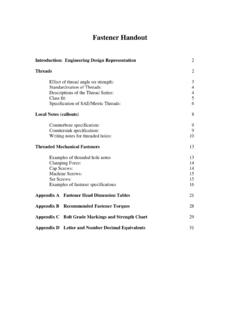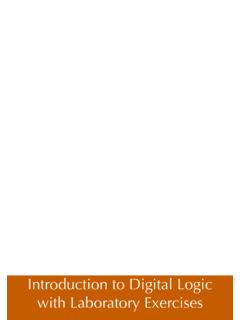Transcription of Simplified Machine Design - kollmorgen.com
1 A Simplified Machine Design Approach for Optimal Servomotor Control 1 A Simplified Machine Design Approach for Optimal Servomotor Control Hurley Gill, Senior Application / Systems Engineer A Simplified Machine Design Approach for Optimal Servomotor Control 2 Available and different technologies present various possible engineering variations and unique operating processes. Then if there is a misunderstanding or knowledge gap, for any given process on the work to be performed, the possibilities expand exponentially and create further complexity with added risk. The intent of this article is to present a Simplified Design approach for servomotor utilization to overcome many of the initial challenges. The approach is based on several different but typical mechanical axis configurations and requirements that highlight risk management, optimal performance and reduced development time. When considering a Machine Design there are clearly many factors to address in the planning phase.
2 Reviewing all the possible situations to reduce risk of failure as well as working through the different combination scenarios, all the ands, ifs and buts, are a demanding set of tasks. For this reason, it s essential to build baseline knowledge of Machine functions and each of its axes, relative to the overall chosen operating process and work to be performed. Start by developing a thorough understanding of the chosen process to complete the Machine s function, the full picture encompassing the ins and outs, as well as identifying any variables and trade-offs, and recognize there likely will be some unknowns. This extends to the advantages and disadvantages of available motion technologies considered and applied to each axis of the Machine . Acquiring as much in-depth comprehension upfront will undoubtedly alleviate potential issues downstream and greatly enhance the opportunity for successful execution. Also, at the center of the Design is risk management of specific technologies available and their interface with each other, related to the trade-offs and decision priorities to be given to the Machine s function for the desired process.
3 Closer Review of Technologies and Varying Degrees of Performance What is considered high technology performance for one manufacturing process is not necessarily high performance for another. It is natural for the Machine builder to deploy technologies they have experience with. However, new challenges often entail the utilization of newer technologies. When a retrofit or a new Machine Design requires the utilization of closed-loop (servo) motion control technologies, there are often misconceptions involved. For example, misconceptions often occur between what was required for a Machine s optimization utilizing previous technologies and what is now required for a Machine s optimized performance. Proper deployment of closed-loop motion control technologies requires balancing its capabilities, trade-offs and other factors that will enhance the new Machine s performance. Previous technologies may include, but are not limited to, hydraulics actuators, variable speed motors, pneumatics or any number of the typical open-loop, ON-OFF control and in some cases, semi or pseudo closed-loop technologies.
4 Even newer closed-loop control concepts must be considered or balanced with older concepts to reduce risk. For example, it may be a great enhancement to run a Machine and control all its axes by a virtual master axis. However, if one axis is essentially driven by two or more motors (hard coupled or pseudo coupled mechanically by the mechanism / load), the additional latency of one motor s drive talking to another through the virtual master s control, rather than directly to each other, will increase risk as a function of speed the Machine is to operate. An often asked question from industrial Machine builders or integrators is how can they effectively Design or implement the conversion of a Machine with servo technology to meet performance expectations. This is a specialized task filled with layers of complexity that can prove difficult to execute, even when the scope of work is fully understood. A Simplified Machine Design Approach for Optimal Servomotor Control 3 In general, any process that is to be sped-up or to run at a faster rate requires a Machine with the capability of faster response times than its previous Design to maintain quality.
5 In other words, the Machine must have the capability to move and act on the product at a faster rate and to respond to all commands and disturbances within the limit of the product and process itself. Often an actual process time is fixed and cannot be increased under an existing technology, leaving only product transfer times as the available time to be sped-up. In turn, this increases specific axis peak horsepower (hp) requirements during acceleration/deceleration times from its baseline by the product of the increased ratio: speed and torque (a 15% increase of each, speed and torque, during peak requirements is a hp increase). Many of the issues involved, when converting a process Machine from some form of open-loop, ON-OFF (bang-bang) control or pseudo closed-loop control method to a closed-loop servomotor controlled Machine , may not be particularly intuitive to a first-time servo Machine designer. Identifiable Issues Below: Inertia.
6 Inertia was not a concern or even a consideration in the past for some specific axes of a Machine Design . For some other axes, an optimal Machine required a high system inertia (load and actuator) to dampen any disturbance from being seen by the product. We want to utilize a high performance servo to increase speed and thus productivity, with the same or improved quality. This requires axes with higher BW (bandwidth) capability than most previous designs in order to sense commands, product changes and disturbances, such that we can respond to errors (delta ( ) between: command and actual) and make the appropriate corrections, both quickly and easily. In order to accomplish these tasks a lower system inertia is generally desirable and most frequently required. This is especially true of processes requiring point-to-point moves or on-the-fly corrections for continuous or pseudo continuous processes. Production energy costs are often reduced by the higher levels of production efficiency.
7 Mechanical Advantage by Gears. Another issue that occurs especially with previously designed machines is backlash within an axis s mechanism. Often this type of axis movement was only mildly considered a potential process issue. The reason is because the unidirectional driven advantaged mechanism driving against the load, pretty-much stays on one side of the mechanism s backlash. However, with the constant velocity correction of a servomotor, the full +/- displacement is repeatedly seen. Mechanical Advantage by Timing Belt. For many previously designed machines (especially uni-directionally driven), the amount of compliance produced by a belt is typically not a major concern in regards to the process, as long as it is sized large enough so that it does not break. However, with the constant velocity correction of a servomotor, the full +/- displacement of the belt s compliance can be repeatedly seen. The typical doubling of the belt s width (as calculated for a unidirectional mechanism) to reduce compliance may make the belt too wide.
8 In this case, the designer may need to utilize as much width as the available space will allow and if possible, further reduce belt compliance (increase rigidity) by selecting a stronger or thicker style belt. {Note: Be careful. A thicker belt reduces compliance (desirable), but lowers natural resonance frequency (undesirable) depending on where the frequency is within the control system s spectrum. Then there is another issue, a larger belt will have a greater side load that must be considered in the Design (bearings, tensioners, pulleys, and/or motors could be affected).} For many designers, these new issues can present hard concepts to get through at first. Because what worked for a host of different open-loop, ON-OFF control and pseudo closed-loop control technologies, is now in part or as a whole, a potential hindrance against the new Machine Design , impacting the desired goal for Mechanically advantaged mechanism by a belt and planetary gearhead Illustration of gears and backlash A Simplified Machine Design Approach for Optimal Servomotor Control 4 increased production and quality.
9 Thus this new Design may need additional effort from the mechatronic designers with typical disciplines in mechanical, electrical, electronic, control, process and programming fields in order to simplify and achieve the goals of risk management, optimal performance and reduced development time. Minimize the Potential Process Issues Involved with the New Design Typically, when utilizing a servo system technology to meet this overall goal, the designer will need to enhance the BW (bandwidth) response capability for each axis of the new Machine . To accomplish the task, we must consider a number of variables. They include frictional loads and any external loading (gravity or otherwise), the inertia between the load reflected back to the motor for a practical controllable solution within the process required tolerances and also the backlash and compliance of each axis. For a typical servo mechanism, it is desirable to have a rigid style (compression, etc.)
10 Coupling to minimize compliance. For many direct-drive axes, the steel s compliance between the motor and load can be a limiting factor. The steel s compliance can affect the ultimate BW of the servo control loops. Even a Machine s frame compliance can become a major player against axis BW capability, motion stability and controllability, where with previous technologies it may not have been of any concern. For example, to achieve the best possible axis BW capability, controllability and minimal risk of any issues for direct-drive cartridge motors, it is very important to Design the driven shaft (if applicable) with an outside dimension (OD) as large as possible for as long as possible, with an overall shaft length as short as possible. (Use as large an ID bearing here as possible to help system BW.) Direct drive cartridge motor technology utilizes a Machine s bearings to support the rotor of a full-frame motor for the ease of installation, and can often eliminate the need for a mechanical advantaged mechanism (gearheads, pulleys and belts, etc) like other direct-drive motor designs.














